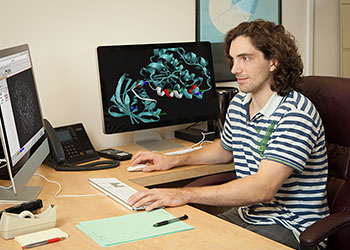Will Model How Proteins Change Shape in Response to Calcium
 Jacob Ezerski, a second-year Ph.D. student in the University of Houston’s Department
of Physics, was awarded a $26,400 National Institutes of Health predoctoral training
fellowship from the Houston Area Molecular Biophysics Program (HAMBP), which is a
collaborative graduate program with biophysics faculty from six major universities
in Houston. This fellowship, which can be renewed for two additional years, will support
Ezerski’s research on modeling how the proteins calmodulin and Calmodulin-Kinase-II
(CaMKII) change shape to fit each other as a result of calcium signaling. Ezerski’s
advisor is Margaret Cheung, associate professor of physics in the College of Natural
Sciences and Mathematics.
Jacob Ezerski, a second-year Ph.D. student in the University of Houston’s Department
of Physics, was awarded a $26,400 National Institutes of Health predoctoral training
fellowship from the Houston Area Molecular Biophysics Program (HAMBP), which is a
collaborative graduate program with biophysics faculty from six major universities
in Houston. This fellowship, which can be renewed for two additional years, will support
Ezerski’s research on modeling how the proteins calmodulin and Calmodulin-Kinase-II
(CaMKII) change shape to fit each other as a result of calcium signaling. Ezerski’s
advisor is Margaret Cheung, associate professor of physics in the College of Natural
Sciences and Mathematics.
Calcium Signaling Controls Many Important Biological Processes
“Calcium ion signaling is a method for many important biological processes to happen,” Ezerski said. “Anything that happens in your brain occurs from different chemical signals. If a neurotransmitter induces the release of calcium ions from a vesicle, then that generates a signal.”
Calcium acts like a signal to turn on and off important processes happening within a cell, similar to the way that we use a remote to turn a television on or to change the channel. How much calcium is released, how fast it is released, and where it is released all affects how this signal is relayed.
The secondary signal protein that calcium binds to, called calmodulin, has four possible binding sites. Depending on how many of these sites are occupied affects calmodulin’s shape and its ability to interact with other proteins, one of which is CaMKII. Misregulation of CaMKII in neurons has been implicated in Alzheimer’s disease.
Ezerski’s research will focus on modeling how these three molecules – calcium, calmodulin, and CaMKII – interact with each other.
Calcium Binding Affects Protein Shape
“I’ll be looking at the conformational change of proteins,” Ezerski said. “The older idea of how proteins interact with each other was the lock-and-key mechanism, which said that one protein has one shape and the other has another shape and if they’re compatible, then they’ll lock together. Now, we think that there is a mutually induced conformation change, with proteins changing shape to fit each other.”
When calcium binds to calmodulin, this binding changes how it conforms, how it moves, and how flexible it is, thus affecting its interactions with other proteins.
“If you have a wave of calcium coming in versus a slow steady rate, then you will get different amounts that bind to calmodulin. Based on this binding, you will have a different conformation, which affects the signal. I am looking at how calmodulin interacts with CaMKII in the presence of calcium,” he said.
Modeling Of Calcium-Calmodulin-CaMKII Interactions
Ezerski will model calcium-calmodulin-CaMKII interactions by using experimental data generated by Neal Waxham’s research group at the University of Texas Health Science Center at Houston. This collaboration was made possible in part due to the opportunities offered by HAMBP.
“At UH, we are at the center of Houston, with direct access to the Texas Medical Center,” Cheung said. “With HAMBP, which has successfully integrated the six research institutes in the medical center, students can be trained together and take classes across the different institutes. This program opens doors, creating opportunities for UH students.”
HAMBP is part of the Gulf Coast Consortia, which brings together seven member institutions to foster interdisciplinary collaborative research teams and training programs in the biological sciences. This year, at HAMBP’s 25th annual Keck Research Conference, Ezerski’s poster won the award for best predoctoral research presentation.
- Rachel Fairbank, College of Natural Sciences and Mathematics